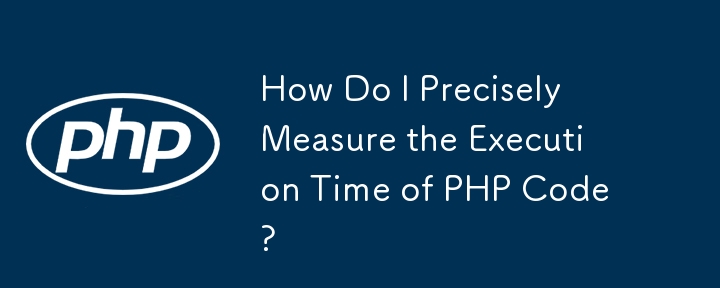Found a total of 10000 related content

Optimize PHP Code: Reducing Memory Usage & Execution Time
Article Introduction:TooptimizePHPcodeforreducedmemoryusageandexecutiontime,followthesesteps:1)Usereferencesinsteadofcopyinglargedatastructurestoreducememoryconsumption.2)LeveragePHP'sbuilt-infunctionslikearray_mapforfasterexecution.3)Implementcachingmechanisms,suchasAPC
2025-05-10
comment 0
461

Calculate the number of days, hours, minutes and seconds between two dates and times in Java
Article Introduction:This article describes how to calculate the number of days, hours, minutes, and seconds between two dates and times using Java 8 and later. It covers parsing date and time strings, time zone processing, and calculating time difference using Duration class. The article provides clear code examples and steps to help developers deal with calculation needs in specific date and time formats.
2025-08-23
comment 0
442


How to get datetime aggregated data by user time zone in MySQL and PHP
Article Introduction:This article elaborates on strategies for handling multi-time zone date-time aggregation in MySQL databases and PHP applications. By explaining MySQL's CONVERT_TZ function and its dependence on time zone system tables, as well as the powerful time zone conversion capabilities provided by the PHP DateTime class, this tutorial aims to guide developers how to accurately filter, group and aggregate data based on the user-specified time zone, thereby avoiding calculation errors caused by time zone differences.
2025-08-24
comment 0
649

php get yesterday's date
Article Introduction:There are three ways to get yesterday's date in PHP: use the strtotime() function, combine the date() function to output detailed time, or use the DateTime class for flexible processing. The first method directly obtains yesterday's date through echodate('Y-m-d',strtotime('yesterday')); the second method can output the full time containing time, minutes and seconds, such as echodate('Y-m-dH:i:s',strtotime('yesterday')); the third method uses the object-oriented DateTime class to facilitate the execution of complex date operations, such as adding and subtracting days or setting time zones, with the code as $date=n
2025-07-04
comment 0
172

How Does the JIT (Just-In-Time) Compiler in PHP 8 Boost Performance?
Article Introduction:PHP 8's Just-In-Time (JIT) compiler dramatically boosts performance by compiling frequently executed bytecode to optimized machine code. This significantly reduces execution time, improves throughput, and lowers CPU usage, especially for computation
2025-03-10
comment 0
689

How to improve CSS performance?
Article Introduction:The core of improving CSS performance is to reduce the overhead of browser style calculation and layout reordering. Specific methods include: 1. Avoid the use of complex selectors, such as deep nesting, wildcards and attribute selectors, and it is recommended to use efficient class selectors; 2. Reduce style reordering and redrawing, avoid frequent layouts by modifying class at one time, using GPU accelerated attributes, and batch operation of DOM; 3. Reasonably split CSS files, prioritize loading of key styles, compress and merge code to reduce volume; 4. Use BEM naming specifications to reduce conflicts, improve maintainability, thereby optimizing page rendering speed and enhancing user experience.
2025-07-23
comment 0
416

How to Profile PHP 7 Code to Find Bottlenecks?
Article Introduction:This article explains how to profile PHP 7 code to identify performance bottlenecks. It details using tools like Xdebug, Blackfire.io, XHProf, and Tideways, analyzing profiling results (execution time, memory usage, call counts), and addressing com
2025-03-10
comment 0
378

How does Java work?
Article Introduction:The running mechanism of Java programs mainly includes compilation into bytecode, JVM execution and automatic memory management. First of all, Java code is compiled into platform-independent bytecode (.class file) through javac, realizing "write once, run everywhere". Next, the JVM loads the bytecode and interprets it by the execution engine or compiles it into machine code through JIT. At the same time, the JVM is also responsible for class loading, memory management and garbage collection. Then, the class loader (ClassLoader) loads class files from disk or network, and the runtime data area includes heap, stack, method area, etc. for data storage for program operation. Finally, the garbage collection mechanism automatically recognizes and frees object memory that is no longer in use, avoiding the complexity of manual memory management. The whole process starts
2025-06-27
comment 0
650

Replacing Nested Ifs with the Strategy Pattern in Modern PHP
Article Introduction:To replace nested if statements in PHP, you should use the policy pattern, 1. Define the policy interface; 2. Create a specific policy class; 3. Use context class to manage policies; 4. Select and execute corresponding policies through type selection and execution, thereby improving the maintainability, testability and scalability of the code, and ultimately achieving a clear and decoupled design.
2025-08-07
comment 0
859

Time data aggregation across time zones: Precise processing strategies for PHP and MySQL
Article Introduction:This article explores the complexity of handling time data aggregation across time zones in PHP and MySQL environments, especially how to accurately obtain the minimum/maximum timestamp under user-specified time zones. We will introduce MySQL's CONVERT_TZ function and its time zone table configuration in detail, as well as the flexible application of the PHP DateTime class, provide practical code examples and best practices to ensure that the data aggregation results meet the time zone logic expected by users.
2025-08-27
comment 0
499

Trigger form submission events using Google Tag Manager: A practical guide
Article Introduction:This article aims to help developers understand how to trigger custom events with Google Tag Manager (GTM) after a form is submitted and push related data to the data layer. The article will explain how to correctly trigger GTM events after the PHP backend process form data and avoid event loss issues caused by page redirection. We will provide JavaScript code examples and explain the importance of delayed execution, ensuring that GTM has enough time to process data.
2025-08-12
comment 0
721

How to use PHP online compiler?
Article Introduction:Use PHP online compiler to be convenient and fast, suitable for testing code snippets or learning stages. The process includes: 1. Select a platform that supports new PHP version, has input and output windows, and can save code such as OnlineGDB, JDoodle or Replit; 2. Create a new PHP file in the editing area and write the code; 3. Click the Run button to view the execution results, such as outputting "Hello, world!". However, restrictions should be paid attention to: 1. Lack of a complete server environment and cannot configure Apache or Nginx; 2. File read and write permissions are limited; 3. Execution time may be limited, and scripts will be interrupted for a long time. For complete project development, it is recommended to build a local environment or use a cloud server.
2025-06-27
comment 0
569

Cross-time zone data aggregation: Time processing strategies in MySQL and PHP
Article Introduction:This article aims to guide developers how to efficiently process time data across time zones in MySQL and PHP, especially when aggregation operations such as MIN/MAX are required based on the user-specified time zone. The article elaborates on the configuration and use of the MySQL CONVERT_TZ function, as well as the application of the PHP DateTime class, and provides specific code examples and best practice suggestions.
2025-08-24
comment 0
846

PHP header location vs javascript redirect
Article Introduction:The jump mechanism of PHP ("Location:...") and JavaScript are different from the applicable scenarios. 1. The execution time is different: PHP is a server-side jump, and the browser jumps immediately after receiving the response, and does not depend on whether JS is enabled; JS is a browser-side jump, and the page is executed after the page is loaded, and it will be invalid if JS is disabled. 2. SEO friendly: PHP is more suitable for SEO, supports 301/302 status code, which is conducive to search engine recognition; JS is not friendly enough to crawlers. 3. Interactiveness: JS is more flexible and suitable for jumping based on user behavior or conditions. 4. Security and limitations: PHP uses header()
2025-07-12
comment 0
850

setTimeout JavaScript Function: Guide with Examples
Article Introduction:JavaScript's setTimeout function detailed explanation: Implement delayed execution
setTimeout is a native function in JavaScript that is used to call functions or execute code snippets after a specified delay (milliseconds). This is useful in many scenarios, such as displaying a pop-up window after the user browses the page for a while, or adding a brief delay before removing the element hover effect (preventing misoperation).
Key points:
JavaScript's setTimeout function allows the execution of functions or code snippets after a specified number of milliseconds, which is very useful for tasks such as displaying popups after a certain browsing time.
setTimeout Acceptance letter
2025-02-10
comment 0
958

How to simplify performance monitoring in PHP projects using Composer
Article Introduction:When developing PHP projects, we often need to monitor the execution time of the code to optimize performance. In one of my recent projects, I encountered a problem: I needed to do precise timing between different code segments, but manually implementing the timer is not only tedious, but also error-prone. After some exploration, I discovered the library phpunit/php-timer, which is easily integrated through Composer, greatly simplifying my work.
2025-04-17
comment 0
312



















